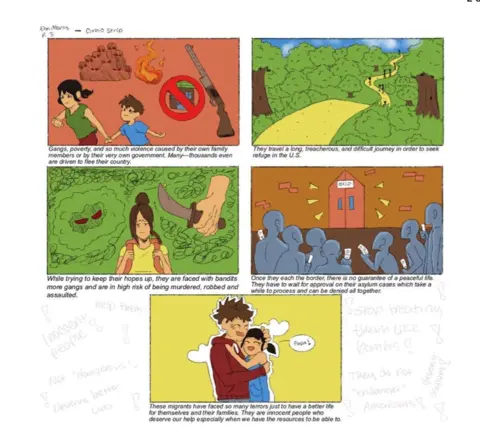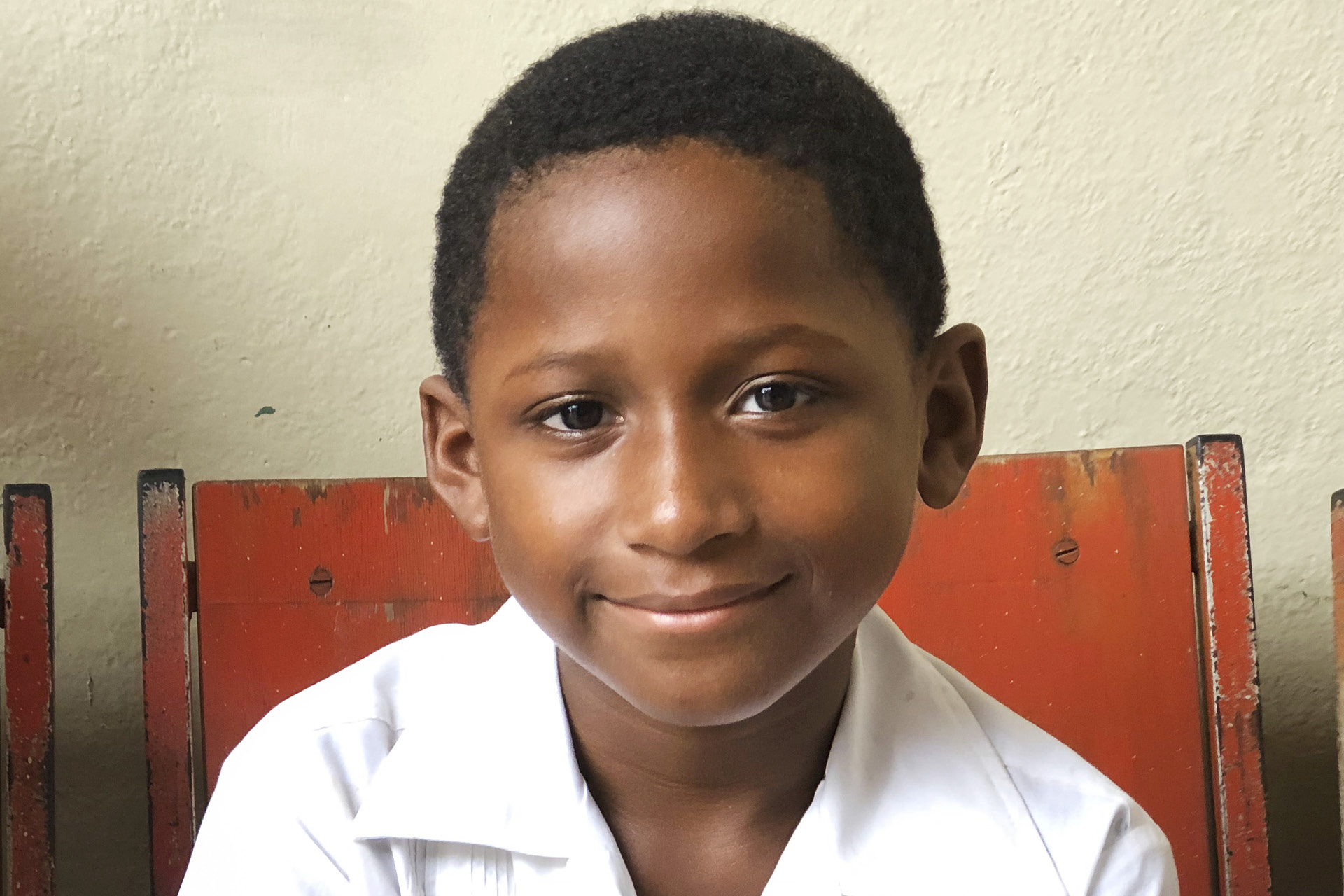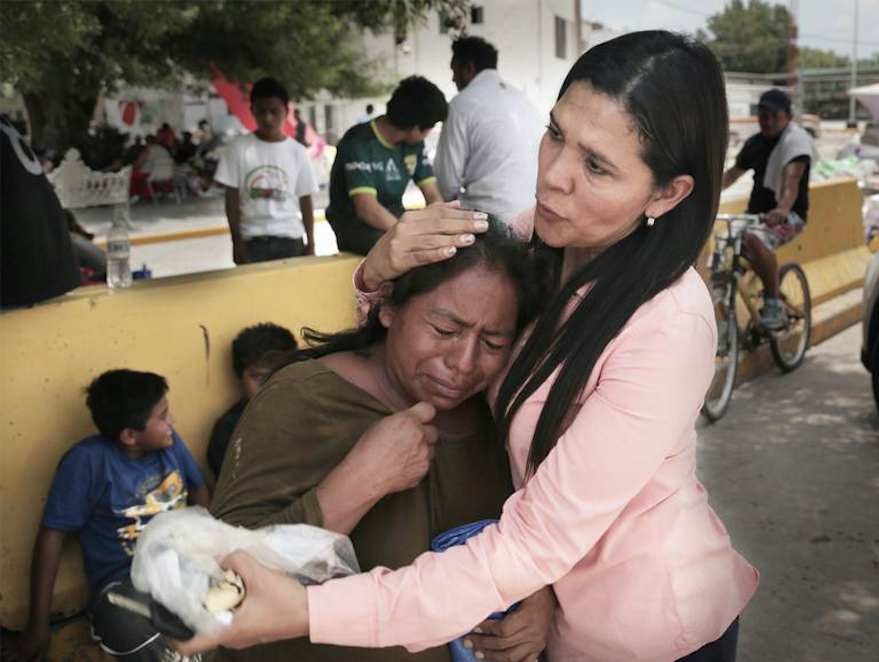This unit was created by Dr. Ingrid Fey, who teaches Ethnic Studies, AP Seminar, and AP Research in Los Angeles, CA, as part of the spring 2021 Pulitzer Center Teacher Fellowship program on Stories of Migration. It is designed for facilitation across approximately four 75–90 minute live or virtual class periods.
For more units created by Pulitzer Center Teacher Fellows in this cohort, click here.
Unit Objectives:
Students will be able to…
- Critically analyze media depictions of migration from Central America.
- Explain the complex causation behind migration by youth from Central America.
- Trace the routes traveled by youth migrants from Central America to the U.S. southern border with Mexico and describe the challenges immigrants face on their journeys.
- Explain the impact of US policy in Central America on migration patterns to the U.S.
Unit Overview:
How does media coverage of migration shape how Americans’ views of migration by youth? Why are so many young people trying to migrate to the United States? What are their journeys like? What happens when they get to the U.S.-Mexico Border? What role does U.S. policy play in this situation? These are the major questions that students will explore in this 4-day mini-unit, which results in media literacy and creative assessments.
Since 2014, the number of unaccompanied children migrating to the U.S. has continued to grow, as has the percentage of migrants who are apprehended at the U.S.-Mexico border While it remains the case that the majority of apprehensions are of single adults and families with children, the increasing number of unaccompanied minors (children under 18) arriving at the U.S,/Mexico border present unique challenges for U.S. immigration authorities because they have different rights related to the length of time they may be held in immigration authorities’ custody , and their ability to remain in the country while their asylum cases are being processed, than the rights given to adults. The Trump administration worked to weaken these legal protections for what they termed “unaccompanied alien children” (UAC) by cutting funding for legal support and giving judges more freedom to determine whether or not an asylum applicant qualified as an unaccompanied child asylum seeker (PBS).
In the early months of the Biden administration, unaccompanied youth asylum seekers overwhelmed unprepared immigration authorities at the U.S. southern border. Press coverage of immigration detention facilities showed hundreds of children packed into inadequate holding cells, facing wait times for processing by immigration officials that significantly exceeded legal limits. Despite these depictions, experts on immigration patterns contended that migration at the start of the Biden administration did not constitute a “surge.” In March 2021, researcher Tony Payan even asserted that “the...situation at the border is neither a unique crisis nor the result (yet) of Biden’s policies” (Roberston). That said, however, March 2021 had the largest monthly number of unaccompanied children ever recorded, with nearly 19,000 young migrants presenting themselves at the border (Spagat and Jaffe).
Despite the fact that overall immigration numbers are not nearly as high as historical peaks, media portrayals of unaccompanied youth migrants from Mexico and Central America often employ dehumanizing language to describe them and their potential effects on U.S. society. This mini-unit focuses on helping students to better understand the lived experiences of youth migrants coming to the U.S.-Mexico border with the hope of establishing residency in the United States. Through close examination of Pulitzer Center-supported reporting and other resources, students first analyze press coverage of youth migration. They then examine the causes of youth migration, the journey northward, and how youth are received at the border. The unit culminates with students critically analyzing media accounts and/or creating a project that demonstrates their empathy for, and understanding of youth migration at all steps along the journey from their homelands to the United States border.
Skills addressed in the unit include analyzing Cause and Effect, Image Analysis (Graphs, Maps, Photographs), Critical Media Literacy, and Creative Writing.
Note: Although the term “unaccompanied alien child” (AUC) has been used by governmental agencies, it is recommended that teachers not use this terminology because it can be dehumanizing. In fact, the Biden administration has moved to remove the term “alien” from immigration policy manuals (Acevedo).
Sources
- “How the Trump Administration Is Rewriting the Rules for Unaccompanied Minors.” PBS, Public Broadcasting Service,
- Acevedo, Nicole. “Biden Seeks to Replace 'Alien' with Less 'Dehumanizing Term' in Immigration Laws.” NBCNews.com, NBCUniversal News Group, 22 Jan. 2021,
- Robertson, Lori. “The Facts on the Increase in Illegal Immigration.” FactCheck.org, 23 Mar. 2021,
- Spagat, Elliot. “Number of Kids Alone at Border Hits All-Time High in March.” AP NEWS, Associated Press, 8 Apr. 2021,
Background Information for Teachers: The Importance of Empathy and Migration Stories
- theRSAorg. “Brené Brown on Empathy.” YouTube, YouTube, 10 Dec. 2013,
- Strom, Adam. “Why Teach About Migration? Because It's the Story of Humankind.”Facing Today - A Facing History Blog,
Four-lesson unit plan, including warm-ups, texts and video resources, discussion questions, activities, a slideshow for teaching each day of the unit, a student work packet for each day of instruction, and performance tasks for the unit.

It is recommended that teachers engage students in both analytical and creative assessments. Examples of both, and descriptions for both performance tasks, are included below.
● Critical Media Literacy Assessment (student example) [.pdf]
● Critical Media Literacy Assessment (student example) [.docx]
● Creative Assessment Comic Book (student example) [.pdf]
● Creative Assessment Comic Book (student example) [.docx]
● Creative Assessment_Acrostic Poem (student example) [.pdf]
● Creative Assessment_Acrostic Poem (student example) [.docx]
● Creative Assessment Original Story (student example) [.pdf]
● Creative Assessment_Original Story (student example) [.docx]
● Creative Assessment Poetry (student example) [.pdf]
● Creative Assessment Poetry (student example) [.docx]
By questioning dehumanizing language in the media, students begin to understand how “othering” representations can make people develop negative biases based upon race, nationality, social status, etc. In turn, such biases may lead to support for oppressive policies which, in this case, include immigration policies.
By completing creative assessments that invite students to imagine what it’s like to be a young migrant, students develop empathy by gaining new perspectives, staying out of judgement, and acknowledging the feelings of others. According to researcher Brené Brown, these three things are at the root of developing a sense of empathy.
Media Literacy Assessment:
The last lesson asks students to analyze an article from the Associated Press and one of several articles for multiple platforms that were supported by the Pulitzer Center that both cover issues related to youth migration. Students analyze language in both articles that is used to characterize youth migrants and identify words that can lead to dehumanization, and words that can lead to a more empathetic reaction.
Creative Assessment:
Creative Assessments can take a variety of formats. Students are invited to choose at least one of the assignments listed below. For whichever assignment(s) they choose, students should draw on details and analysis from the unit as they design their projects. Creative Project Assessment.
- A poem about the youth migrant experience (acrostic poems, “found” poems using words and phrases from the readings and videos, Where I am From Poems, a series of haikus.
- A rap, corrido, or other song regarding the youth migration experience.
- A letter from an unaccompanied child to a friend or family member either in the United States or back in their homeland. The letter may detail their journey, their hopes, their struggles.
- An illustrated map or comic strip detailing the experiences of youth migrants (causes for leaving, struggles along the way, challenges at the border).
- an imaginary interview between a journalist and youth migrants that is either written or filmed
- A children’s book about a young migrant (causes for leaving, struggles along the way, challenges at the border).
- An imaginary journal or diary detailing a young migrant’s journey.
Students’ creative works will be evaluated according to rubrics that assess student demonstration of their understanding of the causes of youth migration, what the journey is like, and what circumstances they face at the U.S.-Mexico border.
United States History Content Standards (UCLA Public History Initiative)
- U.S. Era 10, Standard 2C
- Grades 5-12 -- Analyze the new immigration policies after 1965 and the push-pull factors that prompted a new wave of immigrants. [Analyze cause-and-effect relationships]
- Grades 9-12 -- Identify the major issues that affected immigrants and explain the conflicts these issues engendered. [Identify issues and problems in the past]
Learning for Justice Social Justice Standards
- Diversity 8
DI.9-12.9
I respectfully express curiosity about the history and lived experiences of others and exchange ideas and beliefs in an open-minded way.
- Diversity 9
DI.9-12.9
I relate to and build connections with other people by showing them empathy, respect and understanding, regardless of our similarities or differences.
- Justice 13
J.9-12.9
I can explain the short and long-term impact of biased words and behaviors and unjust practices, laws and institutions that limit the rights and freedoms of people based on their identity groups.
Common Core Standards for Reading and Writing
- CCSS.ELA-LITERACY.RI.9-10.1: Cite strong and thorough textual evidence to support analysis of what the text says explicitly as well as inferences drawn from the text.
- CCSS.ELA-LITERACY.RI.9-10.2: Determine a central idea of a text and analyze its development over the course of the text, including how it emerges and is shaped and refined by specific details; provide an objective summary of the text.
- CCSS.ELA-LITERACY.RI.9-10.3: Analyze how the author unfolds an analysis or series of ideas or events, including the order in which the points are made, how they are introduced and developed, and the connections that are drawn between them.
- CCSS.ELA-LITERACY.WHST.9-10.4: Produce clear and coherent writing in which the development, organization, and style are appropriate to task, purpose, and audience.
- CCSS.ELA-LITERACY.WHST.9-10.5: Develop and strengthen writing as needed by planning, revising, editing, rewriting, or trying a new approach, focusing on addressing what is most significant for a specific purpose and audience.
- CCSS.ELA-LITERACY.WHST.9-10.7: Conduct short as well as more sustained research projects to answer a question (including a self-generated question) or solve a problem; narrow or broaden the inquiry when appropriate; synthesize multiple sources on the subject, demonstrating understanding of the subject under investigation.
- CCSS.ELA-LITERACY.WHST.9-10.8: Gather relevant information from multiple authoritative print and digital sources, using advanced searches effectively; assess the usefulness of each source in answering the research question; integrate information into the text selectively to maintain the flow of ideas, avoiding plagiarism and following a standard format for citation.
- CCSS.ELA-LITERACY.WHST.9-10.9: Draw evidence from informational texts to support analysis, reflection, and research.
- CCSS.ELA-LITERACY.WHST.9-10.10: Write routinely over extended time frames (time for reflection and revision) and shorter time frames (a single sitting or a day or two) for a range of discipline-specific tasks, purposes, and audiences.










